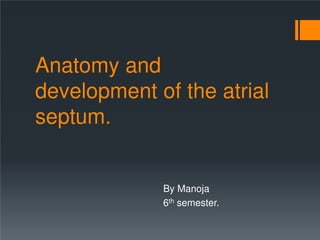
Manoja_Gullapalli_ug
- 1. Anatomy and development of the atrial septum. By Manoja 6th semester.
- 2. Introduction to development of the heart. It develops early in the middle of 3rd week , from aggregation of splanchnic mesodermal cells, in cardiogenic area ,ventral to pericardial coelom, and dorsal to yolk sac. They form 2 angioblastic cords that canalize to form 2 endocardial heart tubes.
- 3. The Heart Tube • The two endocardial tubes fuse to form Single heart tube.
- 4. The heart tube is differentiated into: 1-truncus arteriosus. 2-bulbus cordis. 3-primitive ventricle. 4-primitive atrium. 5-sinus venosus.
- 5. Folding of the heart tube During the 4th week, the folding of the heart tube takes place. The formation of the atrio- ventricular canal and the endocardial cushions also take place around the same time.
- 6. Formation of the Interatrial septum. The septum is developed from three sources: 1. Septum primum 2. Septum intermedium 3. Septum secundum
- 7. • Septum primum: It grows from the roof and dorsal wall of primitive atrium, and passes sagittally downwards. The lower margin of the septum is free and concave. Anterior and posterior hons of the septum fuse respectively with the ventral and dorsal endocardial cushions of the primitive atrioventricular canal.
- 8. • Septum intermedium: The ventral and dorsal cushions of the atrioventricular canal fuse to form a broad anterioposterior partition, which divide the canal into right and left atrioventricular orifices. A foramen known as ostium primum is formed between the upper surface of septum intermedium and lower border of septum primum. Later, ostium primum is closed by the fusion of two septa. Associated with the closure of ostium primum, the upper and dorsal part of septum disintegrates forming a foramen known as ostium secundum.
- 9. Septum secundum: It arises on the right side of septum primum from the space of the right atrium which is interval between septum primum and septum spurium. The septum secundum incorporates the whole of left venous valve, and extends vertically downwards. The lower margin grows sufficiently to overlap the upper margin of the septum primum. The valvular opening formed between the lower margin of the septum secundum and upper margin of the septum primum is called foramen ovale. The valvular foramen ovale is created to regulate the blood flow from the right to left atrium.
- 10. In the fetus (before birth), the pressure is higher in the right atrium than in the left and highly oxygenated blood flows directly from right atrium to left atrium through open foramen ovale. After birth, when the circulation of the lungs begins & the blood pressure in left atrium rises, the upper edge of septum primum is pressed against the upper limb of septum secundum. This will close the foramen ovale functionally, forming a complete partition between the two atria. Later anatomical closure occurs by fusion of the margins of septum primum and secundum. An oval depression in the lower part of interatrial septum of the right atrium, the fossa ovalis is the remnant of the foramen ovale.
- 11. Foramen Ovale Behaves like flap valve. If it is present after the birth i.e. if the anatomical closure does not take place(25% cases), it is present as a remnant of fetal circulation, it opens during increased intra-thoracic pressure.
- 12. Requirement of the passage from the right atrium to the left atrium in the foetus. The source of oxygenated blood is not from the lung but the placenta. Oxygenated blood from the placenta reaches the heart through the inferior vena cava(umbilical vein left branch of portal veininferior vena cava). It enters the right atrium from where it is directed towards the foramen ovale by the valve of inferior vena cava. From the foramen ovale the blood enters the left atrium then left ventricle, from where it enters the systemic circulation.
- 13. Features of the interatrial septum. On the right side: 1. Fossa ovalis: Oval depression in the lower part of the septum, and the floor is formed by the septum primum. 2. Limbus fossa ovalis: It is a sickle shaped fold that surrounds the upper, anterior and posterior margins of the fossa ovalis. It represents lower free margins of the septum secundum. 3. Foramina venarium minimarium: Venae cordis minimi open through these foramina. 4. Atrio-ventricular node: It is situated in the lower part of the septum above the opening of coronary sinus, and in between the annular and looped fibres of the musculature of the right atrium.
- 14. On the left side: 1. Presence of the semilunar fold with the concavity directed upwards; it is a remnant of the upper margin of the septum primum. 2. Lunate impression above the fold is formed by septum secundum. 3. Foramina venarium minimarium.
- 15. Congenital septal defect. If the closure of the interatrial septum does not take place, it results in congenital atrial septal defect(ASD). ASDs account for about 10-15% of all congenital cardiac anomalies. Types of ASDs: 1.Ostium secundum defect→70% of ASDs. 2.Ostum primum defect→20% of ASDs. (with endocardial cushion defect- split in the mitral valve.) 3.sinus venosus defect.→10%of ASDs. 4.coronary sinus septal defect→ < 1% of ASDs .
- 16. Ostium secundum Ostium primum Sinus venosus
- 17. Other congenital amomalies Probe patency of foramen ovale: It takes place when the foramen is closed functionally, but remains patent anatomically. These subjects are considered as normal. Biventricular mono-atrial heart: This is due to complete failure of the septation of primitive atrium. Pre-natal closure of foramen ovale: This is a rare anomaly.
